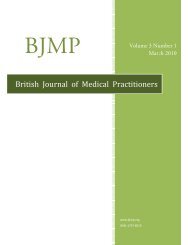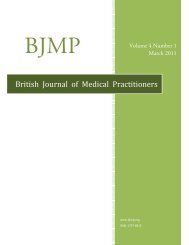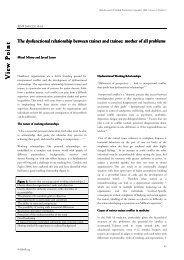R esearch A rticle - British Journal of Medical Practitioners
R esearch A rticle - British Journal of Medical Practitioners
R esearch A rticle - British Journal of Medical Practitioners
Create successful ePaper yourself
Turn your PDF publications into a flip-book with our unique Google optimized e-Paper software.
<strong>British</strong> <strong>Journal</strong> <strong>of</strong> <strong>Medical</strong> <strong>Practitioners</strong>, March 2013, Volume 6, Number 1<br />
Intraoperative cell salvage in obstetrics (ICSO)<br />
Cell salvage has now been used in numerous cases <strong>of</strong> obstetric<br />
bleeds and appear safe. Concerns relate to re-infusion <strong>of</strong> foetal<br />
cells which could theoretically cause haemolytic disease in<br />
future pregnancies and also the potential for amniotic fluid<br />
embolus. If cell salvage techniques are utilised, separate suction<br />
<strong>of</strong> amniotic fluid is recommended and a leukocyte depletion<br />
filter used during re-infusion <strong>of</strong> salvaged blood. Setting up cell<br />
salvage measures should not divert staff an attention from initial<br />
resuscitation.<br />
Intraoperative cell salvage (the process whereby bloodshed<br />
during an operation is collected, filtered and washed to produce<br />
autologous red blood cells for transfusion to the patient) is<br />
commonly being used in cardiac, orthopaedic and vascular<br />
surgery with relative reduction <strong>of</strong> blood transfusion by 39% and<br />
absolute risk reduction by 23%, with cell salvage not appearing<br />
to impact adversely on clinical outcomes 31, 32 . Although large<br />
prospective trials <strong>of</strong> cell salvage with auto transfusion in<br />
obstetrics are lacking, to date, no single serious complication<br />
leading to poor maternal outcome has been directly attributed<br />
to its use. Several bodies based on current evidence have<br />
endorsed cell salvage in obstetrics. Current evidence supports<br />
the use <strong>of</strong> cell salvage in obstetrics, which is likely to become<br />
increasingly commonplace, but more data are required<br />
concerning its clinical use 33 . A National UK survey in 2007<br />
showed that, in 2005–2006, 38% <strong>of</strong> all UK maternity units<br />
were using cell salvage and that 28% incorporated cell salvage<br />
into their massive haemorrhage guidelines 34 . In particular, this<br />
survey showed that a lack <strong>of</strong> training was the main perceived<br />
barrier to its use: 48% <strong>of</strong> units specifically stated that their<br />
reason for not using cell salvage was lack <strong>of</strong> training and<br />
equipment, with fears about safety being expressed by only<br />
10%. However, the potential difficulty is the effective removal<br />
<strong>of</strong> amniotic fluid and the degree <strong>of</strong> contamination with fetal red<br />
cells with potential maternal sensitization, intraoperative cell<br />
salvage may be a useful technique in women who refuse blood<br />
or blood products (Jehovah’s Witnesses guideline) 9 or those<br />
where massive blood loss is anticipated (placenta percreta or<br />
accreta). For women who are Rh-negative, to prevent<br />
sensitization, the standard dose <strong>of</strong> anti-D should be given and a<br />
Kleihauer test taken 1 hour after cell salvage has finished, to<br />
determine whether further anti-D is required 35 .<br />
Recombinant activated factor VII (rFVIIa)<br />
Recombinant activated factor VII (rFVIIa) was developed for<br />
the treatment <strong>of</strong> haemophilia. Over the past decade, it has also<br />
been used to control bleeding in other circumstances. A 2007<br />
review identified case reports <strong>of</strong> 65 women treated with rFVIIa<br />
for PPH 36 .Although the case reports suggested that rFVIIa<br />
reduced bleeding, 30 <strong>of</strong> the 65 women underwent peripartum<br />
hysterectomy and particular caution is required in interpreting<br />
data from uncontrolled case reports. In the face <strong>of</strong> lifethreatening<br />
PPH, and in consultation with a haematologist,<br />
rFVIIa may be used as an adjuvant to standard pharmacological<br />
and surgical treatments. A suggested dose is 90 micrograms/kg,<br />
which may be repeated in the absence <strong>of</strong> clinical response<br />
within 15–30 minutes 37 . Although there is no clear evidence <strong>of</strong><br />
thrombosis with the use <strong>of</strong> rFVIIa in obstetric practice, there<br />
have been case reports <strong>of</strong> thrombosis with the use in cardiac<br />
surgery 38-40 . Women with PPH are particularly susceptible to<br />
defibrination (severe hyp<strong>of</strong>ibrinogenaemia) and this is<br />
particularly relevant to the most severe cases that will be<br />
considered for rFVIIa; rFVIIa will not work if there is no<br />
fibrinogen and effectiveness may also be suboptimal with severe<br />
thrombocytopenia (less than 20 x 10 9 /l).Therefore, fibrinogen<br />
should be above 1g/l and platelets greater than 20 x 10 9 /l before<br />
rFVIIa is given. If there is a suboptimal clinical response to<br />
rFVIIa, these should be checked and acted on (with<br />
cryoprecipitate, fibrinogen concentrate or platelet transfusion as<br />
appropriate) before a second dose is given 36-40 .<br />
Anaesthetic management 15 :<br />
• GA with RSI is generally advocated if actively bleeding or<br />
coagulopathy.<br />
• Reduce dose <strong>of</strong> induction agent if severe on going bleeding.<br />
• Regional anaesthesia is relative contraindication but may be<br />
maintained if the patient has an epidural insitu & bleeding is<br />
controlled.<br />
• Alert Blood bank & haematologist.<br />
• Consider arterial line, central line and urinary catheter but<br />
only after definitive treatment has commenced. Their<br />
insertion must not delay resuscitation & fluid management.<br />
• Use fluid warmer & aim to keep the patient normothermic.<br />
• Regular monitoring <strong>of</strong> haemoglobin level and coagulation<br />
using near patient devices if available (e.g. Haemacue). FFP,<br />
platelets transfusion & cryoprecipitate may be necessary if<br />
coagulopathy develops. Liaise early with haematology<br />
department for optimal & timely product replacement.<br />
• Perioperative monitoring as per AAGBI guidelines.<br />
• Recording <strong>of</strong> parameters on a flow chart such as the modified<br />
obstetric early warning system charts.<br />
• Consider systemic haemostatic agents such as Aprotonin, Vit<br />
K, Tranexemic acid, Recombinant factor VII a (Novo seven<br />
R). Although evidence is conflicting, there is a consensus view<br />
that fibrinolytic inhibitors seldom, if ever, have a place in the<br />
management <strong>of</strong> obstetric haemorrhage 41, 42 .<br />
• Postoperative management includes transfer to ITU/HDU.<br />
• Anticipate coagulopathy & treat clinically until coagulation<br />
results available.<br />
• It is also important that, once the bleeding is arrested and any<br />
coagulopathy is corrected, thromboprophylaxis is<br />
administered, as there is a high risk <strong>of</strong> thrombosis.<br />
Alternatively, pneumatic compression devices can be used, if<br />
thromboprophylaxis is contraindicated in cases <strong>of</strong><br />
thrombocytopenia.<br />
BJMP.org<br />
20







